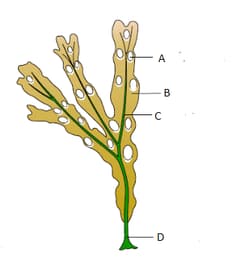Division Thallophyta
Division Thallophyta: Overview
This Topic covers sub-topics such as Algae, Economic Importance of Algae, Classification of Algae, Chlorophyceae, Phaeophyceae, Rhodophyceae, Asexual Reproduction in Algae, Vegetative Reproduction in Algae and, Photosynthetic Pigments in Algae
Important Questions on Division Thallophyta
A research student collected certain alga and found that its cells contained both chlorophyll a and chlorophyll b as well as phycoerythrin. The alga belongs to
Brown algae is characterised by the presence of
Match column-I with column-II and choose the correct option:
| Column-I | Column-II | ||
| A. | Phaeophyceae | I. | Funaria, Sphagnum |
| B. | Rhodophyceae | II. | Equisetum, Pteris |
| C. | Pteridophytes | III. | Ectocarpus, Laminaria |
| D. | Bryophytes | IV. | Polysiphonia, Gracilaria |
The absence of chlorophyll, in the lowermost cell of Ulothrix, shows
In Chlorophyceae, sexual reproduction occurs by
In Ulothrix/Spirogyra, reduction division (meiosis) occurs at the time of:
The common mode of sexual reproduction in Chlamydomonas is
The product of conjugation in Spirogyra or fertilization of Chlamydomonas is
Sexual reproduction involving fusion of two cells in Chlamydomonas is
Which of the following is incorrectly matched?
Read the following statements:
I. Food is stored in the form of laminarin.
II. Cell wall is covered on the outside by a coating of algin.
III. Reproduce asexually by non-motile spores.
IV. All the members contain pyrenoid in chloroplast.
Select the pair of incorrect statements with respect to members of Phaeophyceae.
Air bladders are found in the following plant:

In the above figure label A, B, C and D respectively are :
